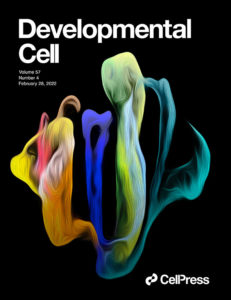A collaborative team led by Geoffrey Schiebinger at the University of British Columbia, Philip Benfey at Duke University and Uwe Ohler at Humboldt Universität zu Berlin has developed an atlas that maps gene expression patterns in the Arabidopsis root, profiling nearly 100,000 single root cells and combining the information with previously published datasets. The work was recently published in the journal Developmental Cell and provides a community resource that could help researchers track cell development and how they determine identity, as well as the roles played by neighboring cells in these processes.
Animation showing 3D UMAP of the atlas with cell type annotations, related to Figure 1. (Developmental Cell 2022 57543-560.e9. doi:10.1016/j.devcel.2022.01.008)

The article was featured on the cover of the February 28, 2022 Developmental Cell issue, with art adapted from the 3D image by study co-author Che-Wei Hsu. Oil-paint-like strokes represent the flow of development in plant roots. Different colors represent different cell types, and the ombré color gradient represents gradual changes over developmental time.
One of the study’s co-authors is Benjamin Cole, a research scientist at the U.S. Department of Energy (DOE) Joint Genome Institute (JGI), a DOE Office of Science User Facility located at Lawrence Berkeley National Laboratory (Berkeley Lab). “This represents the largest integration of single-cell datasets in plants and provides a foundation for still larger efforts in diverse plant species beyond models,” he said.
Cole annotated cell types in the plant root atlas, and noted that the approach he developed for this purpose is “particularly applicable for non-model species for which fewer ‘marker’ genes are known that are hallmarks of different cell types.” His contribution to the paper also aligns with his DOE Early Career Research Program (ECRP) award, which is also focused on single-cell and spatial transcriptomics technologies.
JGI Science Programs Deputy Axel Visel provided a broader perspective: “This exciting work is well aligned with the JGI’s growing efforts in establishing plant and fungal single-cell and spatial transcriptomic technologies, as described in the JGI Strategic Plan (download a copy here). The present paper provides a foundational data set that is now available through a new single-cell data viewer that was collaboratively developed for this purpose by the JGI plant comparative genomics data portal Phytozome and will be available for future single-cell projects.”
The Berkeley Lab Biosciences Area has been leading efforts in developing and applying plant single-cell capabilities for DOE mission questions. One of the first papers ever applying single-transcriptomics to plant tissues, also co-authored by Cole, started with Lab-funded research by then-Biosciences scientist Diane Dickel in 2017. In 2019, plant single-cell methods were officially called out as one of four program development areas for one of the Area divisions. Dickel, and more recently Cole, have been leading these efforts, which included two workshops with resulting reports and a perspective article.
Publication:
- Shahan R et al. A single cell Arabidopsis root atlas reveals developmental trajectories in wild type and cell identity mutants. Dev Cell. 2022 Feb 28. S1534-5807(22)00033-8.doi: 10.1016/j.devcel.2022.01.008
Relevant Links:
- JGI Plant Comparative Genomics Portal Phytozome
- Single-Cell Data Viewer Tool on Phytozome
- JGI Genomics of Plant-Microbial Interactions Group
- Biosciences News: Plant Single-Cell Solutions for Energy and the Environment Workshop Report
- Biosciences News: Plant Single-cell Solutions for Energy and the Environment Workshop Report Released
- Berkeley Lab News: Five Berkeley Lab Scientists Receive Prestigious Five-Year Research Grant